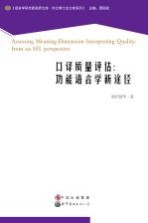

口译质量评估 功能语言学新途径PDF电子书下载
- 电子书积分:9 积分如何计算积分?
- 作 者:萧国政主编;欧阳倩华著
- 出 版 社:世界图书出版广东有限公司
- 出版年份:2015
- ISBN:9787519201807
- 页数:198 页
Chapter 1 Introduction 1
1.1 Disciplinary background of the book 1
1.2 Challenges facing interpreting quality assessment and a possible solution 3
1.3 Research goals ofthe book 5
1.4 Research methods of the book 9
1.5 Organization of the book 11
Chapter 2 Defining consecutive interpreting in the context of interpreting teaching 13
2.1 Defining consecutive interpreting 13
2.2 The transfer of meaning in CI 16
2.3 Teaching consecutive interpreting 22
Chapter 3 Language meaning in interpreting:through the eyes of Systemic Functional Linguistics 25
3.1 SFL:an introduction 25
3.2 Language meaning:three metafunctions 32
3.3 SFL and translation quality assessment 44
Chapter 4 Interpreting quality assessment literature 47
4.1 Empirical studies on IQA 48
4.2 Common Criteria in interpreting assessment 50
4.3 Interpreting quality assessment models for the training purpose 52
4.4 Summary 54
Chapter 5 Status quo of IQA in the training setting 55
5.1 IQA from the eyes of students:the survey 55
5.2 IQA from the eyes of trainers:the interview 64
5.3 Summary 70
Chapter 6 Setting up the model 71
6.1 The issue of validity and reliability 72
6.2 Overview of the model 74
6.3 Implementation of the model 80
6.4 Pilot application of the model 83
6.5 Summary 89
Chapter 7 SFL based quality assessment of students'interpretation 90
7.1 Data collection and corpus building 90
7.2 Assessing C-E interpreting 97
7.3 Assessing E-C interpreting 123
7.4 Summary 142
Chapter 8 SFL based assessment and interpreting teaching 143
8.1 Use the assessment results in interpreting teaching 143
8.2 Notes on model application 154
8.3 Summary 159
Chapter 9 Conclusion 161
Appendix Ⅰ Transcription of source speech of C-E Interpreting 168
Appendix Ⅱ Transcription of source speech of E-C Interpreting 170
Appendix Ⅲ Lexicogrammatical analysis of the C-E ST 172
Appendix Ⅳ Lexicogrammatical analysis of the E-C ST 181
References 186
Postscript 197
- 《程序逻辑及C语言编程》卢卫中,杨丽芳主编 2019
- 《商务英语口译教程 第3版》朱佩芬,徐东风编著 2017
- 《幼儿园课程资源丛书 幼儿园语言教育资源》周兢编 2015
- 《口译理论研究》王斌华著 2019
- 《长三角雾霾突发事件风险评估、应急决策及联动防治机制研究》叶春明著 2019
- 《高等学校“十三五”规划教材 C语言程序设计》翟玉峰责任编辑;(中国)李聪,曾志华,江伟 2019
- 《有机磷酸酯的暴露、毒性机制及环境风险评估》许宜平,王子健等著 2019
- 《音乐语言的根基》张艺编著 2019
- 《认知语言学视野的抽象方位结构研究》曹爽著 2019
- 《激活语言思维》李蒨,王宏年,汤青编著 2017
- 《TED说话的力量 世界优秀演讲者的口才秘诀》(坦桑)阿卡什·P.卡里亚著 2019
- 《小手画出大世界 恐龙世界》登亚编绘 2008
- 《近代世界史文献丛编 19》王强主编 2017
- 《课堂上听不到的历史传奇 世界政治军事名人 初中版》顾跃忠等编著 2015
- 《365奇趣英语乐园 世界民间故事》爱思得图书国际企业 2018
- 《近代世界史文献丛编 36》王强主编 2017
- 《近代世界史文献丛编 11》王强主编 2017
- 《近代世界史文献丛编 18》王强主编 2017
- 《乐队伴奏长笛世界名曲集 4》芭芭拉·哈斯勒-哈瑟 2017
- 《世界名著阅读经典 欧也妮·葛朗台 高老头 全译本 12-16岁》(法)巴尔扎克著 2017
